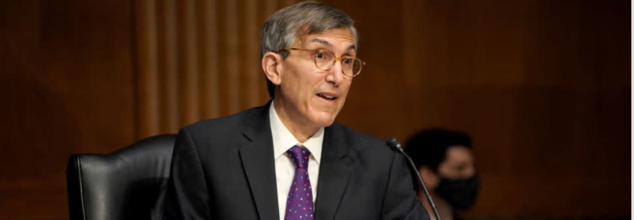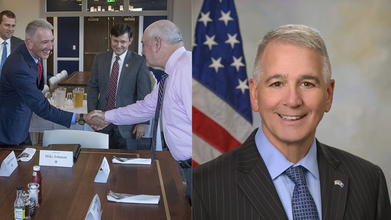- Health Conditions A-Z
- Health & Wellness
- Nutrition
- Fitness
- Health News
- Ayurveda
- Videos
- Medicine A-Z
- Parenting
Top Vaccine Scientist Dr. Peter Marks Ousted From FDA- Will This Shake-Up Put Vaccine Safety At Risk?

Image Credit: Canva
Dr. Peter Marks, one of the top FDA's leaders in vaccine regulation, is stepping down from his position as director of the Center for Biologics Evaluation and Research (CBER). His departure has sparked a debate about the future of vaccine regulation and public health policy. Marks was instrumental in leading vaccine approvals, including during the pandemic brought on by COVID-19. As the FDA makes decisions along this transition, experts wait and monitor how it could potentially affect vaccine safety and public trust.
As the head of the Food and Drug Administration's (FDA) Center for Biologics Evaluation and Research (CBER), Marks Marks played a crucial role in ensuring vaccine safety and efficacy, especially during the COVID-19 pandemic. With his announced departure, concerns are mounting over about the future of vaccine regulation in the U.S. and its potential to affect global public health.
Dr. Peter Marks' Resignation or A Forced Exit?
Dr. Marks' April 5 resignation was not voluntary, according to several sources. He was reportedly told: resign or get fired. His exit occurs under the tenure of Health and Human Services (HHS) Secretary Robert F. Kennedy Jr., a highly publicized vaccine critic.
In his resignation letter, Marks expressed deep concern about the direction of vaccine oversight under Kennedy, writing that undermining confidence in vaccines is "irresponsible, detrimental to public health, and a clear danger to our nation’s health, safety, and security." His letter further suggested that scientific integrity was at risk, accusing Kennedy of prioritizing misinformation over truth and transparency.
Since 2016, Marks has served as the head of the FDA's CBER division, guiding the approval of life-saving vaccines, such as the expedited development and authorization of the first COVID-19 vaccines under Operation Warp Speed. His work introduced mRNA technology into vaccines, which have transformed vaccine development and are being investigated for use against a variety of diseases other than COVID-19, including influenza and cancer.
Under his direction, the FDA also approved the first self-administered flu vaccine, offering a new level of protection against flu season. His time at the agency has been characterized by a focus on scientific integrity and transparency, which experts now worry will be undermined.
Kennedy's Anti-Vaccine Influence
Kennedy has been among the loudest anti-vaccine voices, often issuing inflammatory and widely discredited statements. He has challenged the safety of the COVID-19 vaccine and has been a leading force in attempts to undermine public confidence in vaccination campaigns. In 2021, he submitted a citizens petition requesting that the FDA withdraw COVID-19 vaccine authorizations, deeming them "the deadliest vaccines ever made."
His distrust of COVID-19 vaccines is not an isolated incident. Kennedy has also questioned the measles-mumps-rubella (MMR) vaccine, despite the U.S. experiencing the biggest measles outbreak since 2019. During a recent interview, he asserted that the MMR vaccine "does cause deaths every year," something refuted by the Infectious Disease Society of America, which has identified no deaths attributed to the vaccine in healthy people.
Will Vaccine Safety Be Compromised?
Public health officials are sounding the alarm that Marks' resignation could result in a radical change in vaccine regulation and policy. The FDA's CBER branch regulates not only vaccines but also blood products, gene therapies, and allergenic products. Any loss of its regulatory authority could have sweeping implications.
Issues regarding Kennedy's leadership will result in studies that will misleadingly associate vaccines with autism, a theory consistently disproven by scientific studies. Professionals caution that future research may misleadingly imply a connection between vaccines and autism, which could heighten public fear, reduce vaccination rates, and trigger further disease outbreaks.
Also, Dr. Ashish Jha, dean of the Brown University School of Public Health, characterized Marks' ouster as a loss for the FDA. "To push him out makes the FDA immensely weaker, less effective. This is not how we make America healthy," he posted on X (formerly Twitter).
The Risk of Public Health Setbacks
Marks' resignation can't have happened at a more important time. The U.S. is reeling from the increasing rate of vaccine-preventable diseases. The current multistate outbreak of measles, with its ferocity in Texas, highlights the severity of sliding vaccination rates. According to a report by the World Health Organization (WHO), more than 100,000 unvaccinated children have died last year in Africa and Asia as a result of complications related to measles. These numbers are a hard reminder of how devastating things become when misinformation surrounding vaccines spreads.
At the same time, HHS has allegedly requested the Centers for Disease Control and Prevention (CDC) to reexamine the vaccine-autism connection, in the face of overwhelming scientific agreement that no such connection exists. The action further stoked concern that Kennedy's power might result in policy that negates a half-century of scientific advancement.
What's Next for the FDA and Public Health?
With Marks' departure, the FDA will have a vacuum of leadership at a moment when public health institutions' trust is already weakened. His replacement will have to contend with upholding scientific integrity while dealing with pressures from an administration that seems more and more politicized to counter anti-vaccine sentiment.
The next few months will tell if the FDA can resist political pressure and remain committed to its mission of safeguarding public health. For the moment, experts are calling for caution, stressing the need to protect the scientific standards that have long shaped vaccine regulation in the U.S.
Marks' exit is not simply a house-cleaning in bureaucratic circles—more importantly, it signals a possible turning point in how vaccine science is weighed, approved, and disseminated to the general public. Will this be a catalyst for public health disaster or not, the struggle for vaccine science is just beginning.
CDC To Appoint Vaccine-Skeptic Surgeon Ralph Abraham As Deputy Director

Credits: Wikimedia Commons
It is no news that all appointments in the United States' Health Departments that have been made under RFK Jr are of the people who have been vaccine critiques. In a similar scenario, Dr Ralph Abraham, a state surgeon from Louisiana, who had ordered health officials to stop promoting mass vaccination will now serve as the US Centers for Disease Control and Prevention's (CDC) principal deputy director.
It was in February when Abraham instructed health department staff to stop promoting vaccines for preventable diseases.
He wrote in a February 13 internal memo that although patients should continue speaking with their providers about the risks and benefits of vaccination, the health department will stop promoting mass vaccination. The memo was issued on the same day Robert F. Kennedy Jr. was sworn in as secretary of the US Department of Health and Human Services. While his hiring has not been announced by HHS, but his new role has been confirmed. It was first reported by health newsletter Inside Medicine.
Who Are Part Of The CDC?
As of now the CDC does not have a permanent director. Kennedy ousted Dr Susan Monarez from the role in August. Jim O'Neill, who is serving as the deputy HHS secretary said this month that the agency has had "mission creep" and needs to focus on its original mandate.
“We want to … take the people we have and put them to their best use. And secondly, we are always recruiting. We are eager to hire wonderful scientists and data engineers and AI engineers and researchers and drug reviewers across the department, including CDC. If you are talented, you care about health or human services – please come work with us.”
What More Do We Know About Ralph Abraham?
The news of his appointment comes days after the CDC changed its guidelines on vaccines on its website. The CDC website now links vaccines with autism and states that "vaccines do not cause autism is not an evidence-based claim".
While Abraham has not outrightly been anti-vaccine, he had asked the health staff to not promote it for preventable diseases or infection and has long echoed Kennedy's 'Make America Healthy Again' (MAHA) rhetoric. He had questioned trust in the pharmaceutical industry and public health institutions.
“The solution to increased spending and declining outcomes in our country is unlikely to come in the form of a pill or a shot,” Abraham said in a February statement. “Much of the solution will likely come down to the usual hard work of improving diet, increasing exercise, and making better lifestyle choices.”
Changes In CDC
Apart from the guidelines being changes on autism and vaccine link, in August, Kennedy dismissed all members of the CDC's Advisory Committee on Immunization Practices (ACIP), the body whose recommendations form the basis of state immunization mandates.
Just days later, eight new members were named—though one withdrew amid ethics concerns. Unlike their predecessors, this panel includes only one epidemiologist and one infectious disease specialist, with no virologists or immunologists. Many appointees lack peer-reviewed vaccine research altogether, and those who do have published, on average, 78% fewer vaccine-related papers than former members.
Are Fluoride Levels In US Drinking Water Harmful? New Findings Link Them to Stronger Teen Cognition

Credits: Canva
The long-standing practice of adding fluoride to community drinking water in the United States is now under sharp review as questions rise about whether its advantages continue to outweigh possible risks. A fresh set of findings pushes back against recent warnings about fluoride in water and suggests that it might offer added benefits.
This renewed national discussion began after a government report from the National Toxicology Program stated that high fluoride exposure was tied to lower IQ in children. That report, however, assessed fluoride amounts that were at least twice higher than federal recommendations and had limited information about what happens at lower, commonly used levels, as per CNN.
However, the latest study examined fluoride quantities that match the usual suggested range in drinking water. Researchers found strong evidence showing that children who grew up with water containing these lower levels of fluoride performed better on cognitive assessments than those who had no fluoride exposure.
Fluoride in US Public Water Faces Renewed Questions
Dr. Rob Warren, lead author of the study released in Science Advances, said he was surprised by the National Toxicology Program’s earlier conclusions and felt the need to produce evidence more suitable for public policy. He explained that he pursued the work because it was a major question without a clear answer.
The national debate has also intensified as US Department of Health and Human Services Secretary Robert F. Kennedy Jr. has labeled fluoride an industrial waste and pointed to possible IQ loss while calling for a rollback of federal guidance. Utah and Florida have already moved to prohibit fluoridation of public water.
As per CNN, Warren compared the situation to testing a heart medication. If the advised dose is 100 milligrams, but a study measures reactions to nearly a million milligrams, the results do not reflect what happens at the normal dose. He said that this is how much of the fluoride research has been structured and that only extremely high doses have shown harmful effects, which is not helpful for policy decisions.
Warren directs a long-running program that began in the US Department of Education and has followed tens of thousands of Americans from their high school years in the 1980s through several decades.
Fluoride and Cognition: What The Study Found
For the current analysis, the team linked math, reading and vocabulary test scores from nearly 27,000 participants to the level of fluoride in their childhood drinking water. These measurements were based on older records from the US Geological Survey and the Department of Health and Human Services, as per CNN.
Researchers worked under the assumption that participants spent their entire upbringing near their high schools. They sorted people into three groups. One group had steady exposure to recommended fluoride levels either through natural sources or public water treatment. Another group never had fluoride in their water. A third group had mixed exposure because their community changed its water policy at some point.
Students who had fluoride for only part of their childhood scored higher on tests than peers who never had it. Those who grew up with fluoride throughout all their childhood years scored even better. Follow-up testing that continued up to 2021, when many had reached about 60 years of age, also showed no sign that fluoride contributed to cognitive decline.
Warren clarified that cognitive tests are not exact IQ scores, although they relate strongly. Test results reflect both mental ability and the learning opportunities a person receives. He is currently working on a follow-up project that will look more closely at fluoride and IQ with improved childhood location data.
Other studies this year suggested that removing fluoride from public water in the United States could lead to more than 25 million extra cavities among children and teenagers in five years along with nearly 10 billion dollars in dental treatment costs. Although the new study did not measure dental health, experts noted that pain from untreated cavities can interfere with a child’s ability to attend school or stay focused, which may influence academic scores.
Why Experts Still Differ on Fluoride Policy
Fluoride occurs naturally in some groundwater and foods. It protects teeth by strengthening enamel, which can be damaged by acids formed from bacteria, plaque and sugar. Communities in the United States started adding fluoride to water systems in 1945 to improve oral health in a cost-effective way.
The American Dental Association and numerous specialists continue to support community water fluoridation. The US Centers for Disease Control and Prevention has also kept its recommendations unchanged. The agency does not have authority to require fluoridation, but it considers 0.7 milligrams per liter the ideal amount.
Recently, the US Food and Drug Administration restricted the use of prescription fluoride supplements. The agency noted that unapproved fluoride products may alter the gut microbiome and that better options exist to protect teeth.
In a written response published with the new research, Dr. David Savitz from Brown University argued that before ending a decades-long public health practice, there must be clear proof of harm at commonly used fluoride levels. He wrote that there is still no convincing evidence that fluoridation lacks benefit or causes damage at recommended doses.
He quoted a well-known saying, noting that if something is not broken, there is no reason to fix it. He said the new study suggests that fluoridated water remains on the side of being effective and safe.
Neuralink: Can Elon Musk’s Brain Chip Help Reverse Paralysis In The Future?

Credits: Canva
The Neuralink chip is a piece of technology that’s hoped will one day allow people to operate devices like phones and computers using their thoughts. Its creator, tech mogul Elon Musk, describes it as a “Fitbit in your skull with tiny wires.” Elon Musk's brain implant company Neuralink said recently that 12 people worldwide have received its chips. The device is meant to have several applications, from restoring motor functionality within people to enabling a brain-computer interface. The question now is whether it will be able to reverse paralysis in the future or not.
Neuralink: What Is Neuralink, And What Does It Do?
Neuralink is a neurotechnology company Musk set up in 2016. The device is roughly the size of a coin and is implanted into the skull, with hair-thin threads placed inside specific parts of the brain to form a working brain-computer interface.
The implant records brain signals and transfers them to an external device, such as a smartphone, through Bluetooth. Its first product, Telepathy, is designed to let a person operate their phone or computer through intention alone. By placing the chip in regions that manage movement, Neuralink believes it could help people living with neurological conditions. Musk has said that early users would likely be people who cannot use their limbs.
Neuralink: What Testing Has Neuralink Carried Out In The Past?
As per Reuters, the company has run trials using monkeys and pigs. Demonstrations have featured monkeys moving a cursor or playing simple on-screen games using the implant. Neuralink maintains that no monkey died because of the device itself, though reports have circulated describing complications in some animals, including paralysis, seizures and swelling in the brain.
Neuralink: Can Neuralink Cure Paralysis?
The human brain contains millions of neurons responsible for movement, emotion and thought. These neurons send electrical signals down pathways that run from the brain to the rest of the body. If a person tries to stand up, the brain sends electrical instructions to the legs, and the reaction is instant. Paralysis develops when pathways in the spinal cord are damaged or blocked, according to the description on Neuralink’s website.
Because the Neuralink implant reads the brain’s signals, it can forward those signals to the limbs even when the spinal cord no longer relays them. This would require one implant in the brain and another placed below the injured area of the spinal cord. With steady training, a person could regain movement, raising the possibility that Neuralink may one day help restore mobility.
Neuralink Ethical Concerns
Experts have questioned the company’s experiments on animals and the general risks linked to brain operations, which can include seizures or bleeding. They have also pointed to worries about data privacy and long-term surveillance, since there is limited detail on how much control users will have over their neural information.
Earlier this year, the US Department of Transportation fined the company for failing to register as a carrier of hazardous biological material, including implants removed from primates, according to agency records reviewed by Reuters.
Neuralink Is FDA Approved
In late May 2023, the FDA granted Neuralink permission to start human testing. The company said on Twitter that the approval marked the beginning of its first clinical study in people, calling it a vital step toward making the technology accessible in the future.
Neuralink has continued to share updates, and in July 2025, it announced that it had completed two brain-implant procedures on the same day. Both individuals are said to be recovering well. Musk responded soon after, expressing confidence in what the technology might achieve in the coming years.
© 2024 Bennett, Coleman & Company Limited

